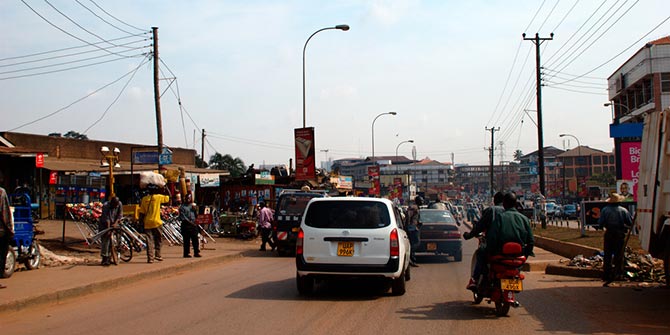Dagna Rams argues Bolt’s book should appeal to anthropologists interested in borderlands and political economy of agriculture.
Maxim Bolt’s book Zimbabwe’s Migrants and South Africa’s Border Farms: The Roots of Impermanence shines a light on the life of the South African borderland with Zimbabwe, where white farmers escaping Mugabe’s repressive politics moved to establish themselves and hired a black workforce. The resulting operations are fertile in seeming contradictions: while inhabiting “the hyper-policed edge of the national territory” (p. 69), the farms hired mostly migrant workers; the farms were hubs of wage labour but equally magnets for casual labour; the owners followed a sedentary life and involved in a dynamic search for economic survival outside the farm. For Bolt, the farms turn out to be perfect sites to put under the microscope the meaning of labour and global processes such as neoliberalism. His book brims with anecdotes and minute details of people’s lives.
wage labour but equally magnets for casual labour; the owners followed a sedentary life and involved in a dynamic search for economic survival outside the farm. For Bolt, the farms turn out to be perfect sites to put under the microscope the meaning of labour and global processes such as neoliberalism. His book brims with anecdotes and minute details of people’s lives.
Since its independence in 1980, as the author notes, Zimbabwe under Mugabe’s Zimbabwe African National Union-Patriotic Front (ZANU-PF) strived to redefine Zimbabwean citizenship to the exclusion of whites, farm workers and urban workers for their perceived lack of autochthonous belonging. Some of the excluded whites moved over the border, to the Limpopo Valley to recreate their economies at an arm’s length. Maxim Bolt spent 18 months on one of those farms. He was hired as a casual labourer working alongside black workers. Despite this firmly defined positionality, he explores the place from different perspectives: white men’s, waged and casual workers’, and occasional solitary border guards, who wander into the field as they pursue companionship and sex. The white men derive a sense of superiority from pioneer stories that they tell and re-tell about how they projected their vision onto the empty land to now reap its fruits. The black farmers are divided by class, political background and type of work contract. They forge and fall out of alliances.
Bolt pays attention to resonances between space and life, narratives and feelings. White farm owners are seen as leading solitary lives in their removed luxurious residences. Theories about racial difference are in part the reasons why they feel that they have much work to do and as such have no time to socialise. Black farm workers in turn populate more or less transitory spaces of compounds, where levels of domestication and decoration signpost the length and stability of their contracts. “Workplaces are life places” (p. 5), the author emphasises. The wives who occasionally come to visit momentarily breath in domestic life to what is otherwise life dominated by work.

Committed to the anthropological view from below, the author is careful not to see his field site as a simple example of global processes that could have observed elsewhere. The description of local political economy is nuanced. “Local arrangements are through to be so ad hoc and fleeting that contracts collapse into informality, employment into entrepreneurialism […] But here local centre of capitalist production […] represents centres of gravity, islands of wage labour in a sea of informal arrangements” (p. 5). In consequence, similarities to neoliberalism are the effect of “accidental neoliberalism” (p. 24), where “neoliberal effects here are partially divorced from neoliberal causes” (ibid). The white farmers are not simple “capitalists darting around the globe in hypermobile pursuit of profit” but rather “success in any one farming enterprise requires the investment of considerable time” thus “flexible accumulation is itself dependent on highly non-flexible and structured arrangements” (p. 25).
Bolt’s book fits like a piece of a missing puzzle into the existing scholarship on the region. In the midst of the general economic trends, works about the labour reserve are fewer whilst research about strategies to minimise the effects of economic crisis are published more. As a book that talks about a “hub of wage labour” amidst crisis-ridden border, is in a perfect position to explore the changing economic trends. In the midst of the colonial and post-colonial fixation on borders as crucial for national security and integrity of labour markets, border farms are perfect sites to reveal how these transitions play out.
Bolt’s book should appeal to anthropologists interested in borderlands and political economy of agriculture. Others might find here an interesting insight into the shared economic history of Zimbabwe and South Africa. The book is an ambitious text masterfully jumping scales – from the description micro-workings of a rivalry between two black workers to macro-analysis of relations of labour in neoliberalism. Those who feel that social truth is revealed in everyday details, as well as those look for sure knowledge from statistics and historical records, will all find their preferred path towards understanding labour, capitalism, sovereignty and social change at the borderlands.
Dagna Rams (@dagnna) is a doctoral student at the University of Lausanne. Her research is on politics and informal economies of electronic waste in Accra, Ghana.
The views expressed in this post are those of the author and in no way reflect those of the Africa at LSE blog, the Firoz Lalji Centre for Africa or the London School of Economics and Political Science.





